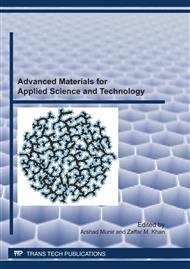[1]
Davies P., Cantwell W., Moulin C. and Kausch H.H. A study of delamination resistance of IM6/PEEK composites, Composites Science and Technology, 36 (1989) 153-166.
DOI: 10.1016/0266-3538(89)90085-7
Google Scholar
[2]
de Morais A.B. and Pereira A.B. Application of the effective crack method to mode I and mode II interlaminar fracture of carbon/epoxy unidirectional laminates. Composites Part A, 38 (2007) 785-794.
DOI: 10.1016/j.compositesa.2006.09.001
Google Scholar
[3]
Hojo M. and Claes-Göran Gustafson (1987). Delamination Fatigue Crack Growth in unidirectional Graphite/Epoxy Laminates, Journal of Reinforced Plastics and Composites, 6: 36-52.
DOI: 10.1177/073168448700600104
Google Scholar
[4]
Kenane M. and Benzeggagh M.L. Mixed-mode delamination fracture toughness of unidirectional glass/epoxy composites under fatigue loading, Composites Science and Technology, 57 (1997) 597-605.
DOI: 10.1016/s0266-3538(97)00021-3
Google Scholar
[5]
Martin R.H. and Murri G.B. Characterization of mode I and mode II delamination growth and thresholds in AS4/PEEK composites, Composite Materials: Testing and Design ASTM STP 1059, 9 (1990) 251-270.
DOI: 10.1520/stp24115s
Google Scholar
[6]
Allix O., Ladevèze P. Interlaminar interface modeling for the prediction of delamination. Composite structures, 22(4) (1992) 235-242.
DOI: 10.1016/0263-8223(92)90060-p
Google Scholar
[7]
Allix O., Ladevèze P., Corigliano A. Damage analysis of interlaminar fracture specimens. Computer Structures, 31(1) (1995) 61-74.
DOI: 10.1016/0263-8223(95)00002-x
Google Scholar
[8]
Allix O., Ladevèze P., Gornet L., Lévêque D., Perret L. A Computational Damage Mechanics Approach for Laminates: Identification and Comparison with Experimental Result. Damage Mechanics in Engineering Materials, Studies in Applied Mechanics, 46 (1998).
DOI: 10.1016/s0922-5382(98)80059-7
Google Scholar
[9]
Peerlings R. H. J., Breklemans W. A. M., de Borst R., Geers M. G. D. Gradient-enhanced damage modelling of high-cycle fatigue. Int. J. Numer. Meth. Engng, 49(12) (2000) 1547-1569.
DOI: 10.1002/1097-0207(20001230)49:12<1547::aid-nme16>3.0.co;2-d
Google Scholar
[10]
Robinson P., galvanetto U., Tumino D., Bellucci G., Violeau D. Numerical simulation of fatigue-driven delamination using interface elements. Int. J. Numer. Meth. Engng, 63 (2005) 1824-1848.
DOI: 10.1002/nme.1338
Google Scholar
[11]
Tron A., Costa J., Camanho P. P., Davila C. G. Simulation of delamination in composites under high-cycle fatigue. Composites Part A: applied science and manufacturing, 38 (2007) 2270-2282.
DOI: 10.1016/j.compositesa.2006.11.009
Google Scholar
[12]
Verpeaux p., Charras T. and Millard A. Castem 2000 : Une approche moderne du calcul des structures. J.M. Fouet, P. Ladevèze, R. Ohayon (ed. ), 1988 ; 227–261. http: /www-cast3m. cea. fr.
Google Scholar
[13]
Juntti M., Leif E. Asp, Olsson R. Assessment of evaluation methods for the mixed-mode bending tests. Journal of Composites Technology and Research, 21(1) (1999) 37-48.
DOI: 10.1520/ctr10611j
Google Scholar
[14]
Leif E. Asp, Sjogren A., Greenhalgh E. S. Delamination growth and thresholds in a carbon/epoxy composite under fatigue loading. Journal of Composites Technology and Research, 23(2) (2001) 55-68.
DOI: 10.1520/ctr10914j
Google Scholar
[15]
Harper P.W., Hallet S.R. Cohesive zone length in numerical simulations of composite delamination. Engineering Fracture Mechanics, 75 (2008) 4774-4792.
DOI: 10.1016/j.engfracmech.2008.06.004
Google Scholar
[16]
Iiaz H. Prediction of delamination crack growth in composite laminates under static and fatigue loadings using cohesive zone model. PhD thesis, Ecole Centrale de Nantes, France, (2009).
Google Scholar
[17]
Gornet L., Ijaz H. High cycle fatigue model for delamination crack growth in CF/Epoxy composite laminates. Accepted for publication in International Journal of Damage Mechanics. Editor: Chaboche J.L. DOI: 10. 1177/1056189510374166.
DOI: 10.1177/1056789510374166
Google Scholar
[18]
Richard W. Hamming. Numerical Methods for Scientists and Engineers, 2nd edition, Publisher: Dover Publications, 1987. ISBN-13: 9780486652412.
Google Scholar
[19]
Beer G. An isoparametric joint/interface element for finite element analysis. Int. J. Numer. Methods Eng., 21 (1985) 585-600.
DOI: 10.1002/nme.1620210402
Google Scholar
[20]
Williams J.G. On the calculation of energy release rates for cracked laminates. International Journal of fracture, 36 (1988) 101-109.
Google Scholar


